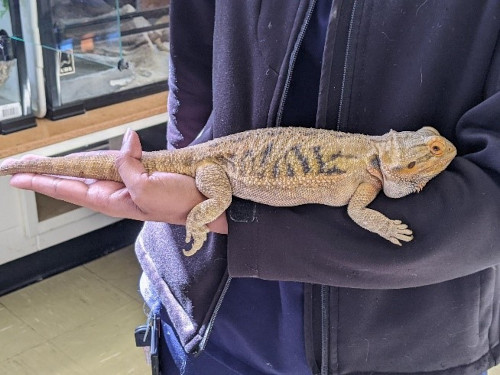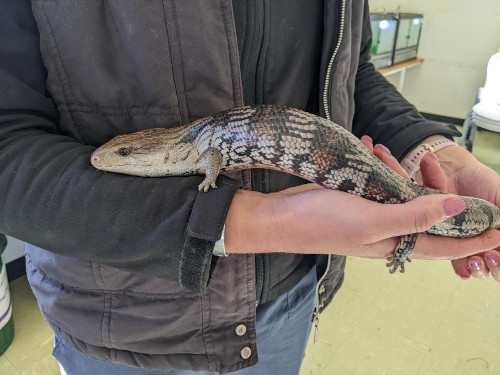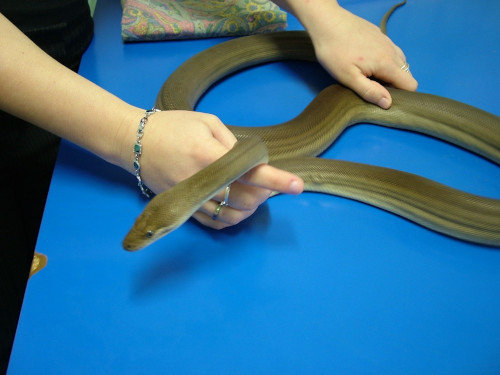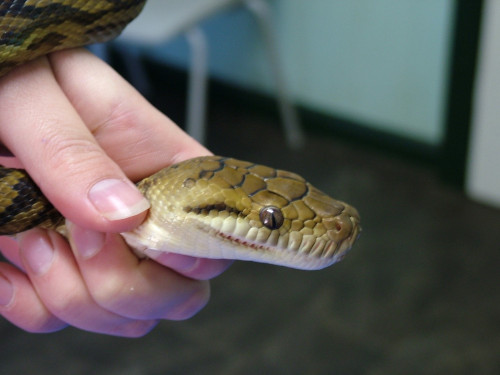No form of handling of your reptile should ever be taken lightly, as each restraint has some effect on their behaviour, life, or other activities. Confidence, knowledge – and often assistance – is required when handling them.
Not only can reptiles hurt you (by biting and scratching), but you can also hurt them with careless handling. Due to their lifestyle, many captive reptiles are physically unfit, overweight, and have weakened bones. Dropping them, failing to support their spine, or holding them incorrectly can cause severe injuries.
You also need to remember that reptiles usually hate being lifted up. While many will accept it, few will like it. It is a stressful event and the best way to reduce that stress is to handle them calmly, safely, and for only a short time.
Depending on the animal’s species various precautions need to be taken.
Lizards
The attitude and behaviour of lizards varies greatly with species, age, and state of health.
- Bearded dragons, except for the eastern species (Pogona barbata), are usually quite docile and easy to handle.
- The larger skinks such as blue-tongued lizards (Tiliqua scincoides) and shingle backs (Tiliqua rugosa rugosa) are also usually placid and accept handling.
- Eastern water dragons (Physignathus lesueurii) are flighty and can be aggressive as adults.
- Many monitors are potentially dangerous, capable of not only biting and scratching, but also using their long tail as a powerful whip.
Be aware of autotomy – the ability of geckos and skinks to drop their tail to distract a predator while the lizard escapes. Unfortunately, this sometimes happens when these animals are handled, particularly if lifted by their tail.
Spinal and leg support is important when handling lizards. If they feel unstable or unsupported, they are more likely to struggle as they attempt to escape, and this can result in injury.
Instead, “Be the rock or the tree” – support the lizard on your hand or forearm with their legs supported, and they will usually relax. If needed, Bearded dragons can be gently restrained by holding the base of their tail with your thumb. Other than that, squeezing them to restrain them is usually not needed and may trigger an escape response.


Stress: Watch for signs of stress in your reptile while they are being handled. When stressed, bearded dragons will darken the skin on their back, sides, and under their chin (the beard). Many reptiles will struggle against handling if they are stressed. If your reptile is getting stressed, it might be best to return them to their enclosure before it gets any worse. Stressed reptiles may become unexpectedly aggressive or, particularly if stressed a lot and often (e.g., by frequent handling), they may fall ill.
Snakes
Most Australian pythons, especially if captive-bred, are usually placid and will accept handling. The scrub python (Morelia amethistina), juvenile Jungle carpet pythons (Morelia spilota cheynei), the green tree python (Morelia viridis), the water python (Liasis fuscus), and the Children’s python (Anteresia childrenii) are the exceptions – many of these listed species can be quite aggressive when handled.
Also, be careful when handling pythons who are shedding, or about to shed, as their skin can be very sensitive and even painful. Snakes who are hungry will be more likely to bite the hand of their handler at feeding time.
Restraining the head of a python will usually cause them to struggle, whereas if they are handled gently by supporting the body only the python will tend to relax. Support the spine at all times – a good rule of thumb, as well as ‘be the rock or be the tree’, is to have one person to every metre of snake i.e., a 3-metre snake will need three people to safely support them when they are been handled.



If you have a large python, longer than two metres, never handle the snake alone. Fatalities have occurred when reptile owners have tried to handle large pythons alone, and the snake has coiled around the owner’s face or neck.
Stress: Watch for signs of stress when handling your python. These signs include loud and constant hissing, increased rate of tongue flicking, passing voluminous faeces and urates, and striking at you (even through the enclosure wall). If this is happening, it is usually best to leave your snake alone. Forcing them to do what you want may make the stress (and aggression) worse.
Turtles
Turtles are generally easy to handle but be careful – a healthy turtle can be surprisingly mobile. Demeanour varies from species to species. Of the commonly kept species in Australia, the common eastern long-necked turtle is quite docile. Short-necked turtles (Emydura species) are usually more mobile and liable to bite.
Turtles do not have teeth, but the strong keratin edge on their lower jaw can deliver a painful nip. On top of this, getting raked by the long claws on their feet is no laughing matter either! This can be avoided by holding them by the rim of the upper shell at the front and back, or at their sides. Another trap to be aware of – the glands at either end of the bridge (the shell between the upper and lower shells) can discharge a pungent fluid!

Stress: Signs that your turtle is becoming stressed include attempts to bite or scratch you, withdrawal of the head, tail, and limbs into the shell, or passing large volumes of urine. If this happens, it is best to walk away and try again when your turtle is less stressed.
Transport
Reptiles should never be transported unrestrained on your body or in the car. If startled, they can injure you – or be injured themselves. Always place them in a safe, comfortable, and secure container for everybody’s safety.
Many different containers are used to transport reptiles including bags, pillow slips, boxes, and bins. It should be noted that any container used to transport a reptile should be leak proof, crush proof, and secure. Special conditions apply for the transport of venomous species.
Never put your hand in a “snake bag” without knowing EXACTLY what is in it!
References
Carmel B, Johnson R (2014) A guide to health and disease in reptiles & amphibians. Reptile Publications, Burleigh
Herrin K (2018) Clinical Techniques and Supportive Care. Reptile Medicine and Surgery in Clinical Practice.
